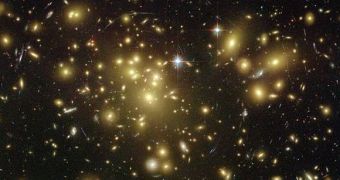The Fermi telescope has recently brought a new ray of hope into the search of dark matter, as new observation results coincided directly with previous analyses of the elusive stuff. Last year, the observatory combined its data with that obtained by the PAMELA (Payload for Antimatter Matter Exploration and Light-nuclei Astrophysics) satellite, and showed large flows of high-energy electrons and positrons moving at fast speeds through space. At the time, it was widely believed that these particles could have been generated by dark matter ones annihilating each other, Nature News informs.
“There's been tremendous excitement about cosmic ray signals that have dark matter as one possible explanation,” New York University expert Neal Weiner explains. This type of matter is widely believed to account for about 85 percent of all types of matter in the Universe. But critics showed last year that the particles identified by Fermi and PAMELA might have originated from regular sources, such as pulsars. “An important question is: how are we going to determine whether it's dark matter or some astrophysical source?” Weiner adds.
For some time, scientists have inferred that looking for high-energy gamma-rays accompanying these emissions could be the way to go. That is to say, if dark matter annihilates itself and emits positrons and electrons, these fast-traveling particles would slam into the photons emitted by average stars, and shift their energies into the high-energy, gamma-ray range. For quite a while now, Fermi has been looking for these gamma-rays, and it would seem that its search has finally started to pay off.
At the TeV Particle Astrophysics conference, held at the SLAC National Accelerator Laboratory, in Menlo Park, California, Fermi telescope team member Persis Drell announced that the observatory had detected spikes in high-energy gamma-rays at the 100 GeV energy range. This level fits theoretical predictions on gamma-rays accompanying the movements of dark matter. The team analyzed data taken from the galactic core, as well as from a significant portion of the sky, known as the Inner Galaxy.
“As FERMI narrows its field of view, its sensitivity will increase, and there are the prospects for some very important and exciting results,” Weiner says. “I think that the way towards the truth is still very long,” Italian PAMELA team member and University of Rome TOR Vergata expert Piergiorgio Picozza adds. He underlines the fact that the long strings of scientific papers analyzing the 2008 discoveries have reached a number of different conclusions, some of which are completely opposite to others.

 14 DAY TRIAL //
14 DAY TRIAL //